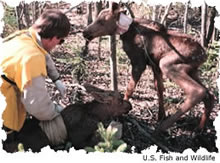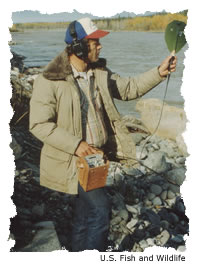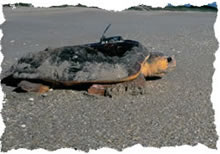For many years the only way to track wildlife was to simply follow and observe the movement and habits of an animal or to capture an animal and put a tag on it and hope that at sometime in the future that same animal would be recaptured. Today, scientists have new tools to help them determine how animals move and how they use their environment.
Tracking with Technology Radio tracking technology can help determine exactly where an animal is at any moment in time and often what that animal is doing! Using the data collected from tracking devices, scientists can determine the day-to-day movements of an animal, the size of an animal's home range, what other animals share an animal's range and the types of habitats an animal uses. By analyzing all this data, scientists can learn new ways to help control animal populations, determine what impact development might have on an animal population, and determine if there are enough individuals of a particular species in an area to allow for reproduction.
There are three types of radio tracking systems used today. VHF Radio Tracking, Satellite Tracking and Global Positioning System (GPS) Tracking.
VHF Radio Tracking  Scientists have been using VHF radio tracking since 1963. In order to use VHF radio tracking, a radio transmitter is placed on the animal. Usually, the animal is first sedated. While the animal is asleep, the scientists gather information about the health and condition of the animal. Scientists have been using VHF radio tracking since 1963. In order to use VHF radio tracking, a radio transmitter is placed on the animal. Usually, the animal is first sedated. While the animal is asleep, the scientists gather information about the health and condition of the animal.
Once the radio transmitter is placed on the animal, it begins transmitting a signal to a radio antenna and receiver. In order to locate an animal using VHF radio tracking, scientists must be close enough to the animal with the radio antenna so they can pick up the signal from the radio transmitter on the animal.
 This works just like a car radio works! When a radio station sends a signal the radio antenna on the car picks up the signal and the radio receiver, when tuned to that radio station's channel, turns that signal into music or talk or whatever the radio station is broadcasting! This works just like a car radio works! When a radio station sends a signal the radio antenna on the car picks up the signal and the radio receiver, when tuned to that radio station's channel, turns that signal into music or talk or whatever the radio station is broadcasting!
Scientists using an antenna and receiver can then locate the animal from a plane in the air or from a vehicle or on foot on the ground by following the radio signal.
Radio transmitters used to be fairly large and were only used on larger animals, but improvements in technology have allowed scientists to create much smaller transmitters that can be attached to small animals. They even make transmitters that can be swallowed by an animal or placed under an animal's skin!
| | | |
Satellite Tracking  Satellite tracking is similar to VHF radio tracking, but instead of a radio signal being sent to a radio receiver a signal is sent to a satellite. With satellite tracking, scientists don't have to be near the animal to pick up its signal. They can track the animal using a computer! This loggerhead turtle is heading out to sea, but scientists will be able to track its movements using the signal the transmitter on its back sends to a satellite. Its a lot easier tracking a loggerhead this way than by swimming after it! Satellite tracking is similar to VHF radio tracking, but instead of a radio signal being sent to a radio receiver a signal is sent to a satellite. With satellite tracking, scientists don't have to be near the animal to pick up its signal. They can track the animal using a computer! This loggerhead turtle is heading out to sea, but scientists will be able to track its movements using the signal the transmitter on its back sends to a satellite. Its a lot easier tracking a loggerhead this way than by swimming after it!
GPS Tracking  GPS tracking is the newest technology being used to track wildlife. In GPS tracking, a radio receiver, not a transmitter, is placed on the animal. The radio receiver picks up signals from special satellites. The receiver has a computer that then calculates the location and movement of the animal. The data gathered by the receiver is then sent to another set of satellites. The second set of satellites then sends the data to the scientists. GPS tracking is the newest technology being used to track wildlife. In GPS tracking, a radio receiver, not a transmitter, is placed on the animal. The radio receiver picks up signals from special satellites. The receiver has a computer that then calculates the location and movement of the animal. The data gathered by the receiver is then sent to another set of satellites. The second set of satellites then sends the data to the scientists.
Tracking small animals using these technologies used to be difficult because the transmitters were so large. Today, scientists are working on ways to make the tracking devices smaller. There are now GPS receivers that are solar powered and small enough to attach to a bird!
In order to learn more about animals and their behavior, scientist use a combination of techniques including: observation of animals in the field and in captivity, research in the laboratory, and tracking and monitoring with technology. These techniques and others help scientists better understand what an animal needs to thrive in an environment. |

 Scientists have been using VHF radio tracking since 1963. In order to use VHF radio tracking, a radio transmitter is placed on the animal. Usually, the animal is first sedated. While the animal is asleep, the scientists gather information about the health and condition of the animal.
Scientists have been using VHF radio tracking since 1963. In order to use VHF radio tracking, a radio transmitter is placed on the animal. Usually, the animal is first sedated. While the animal is asleep, the scientists gather information about the health and condition of the animal. Satellite tracking is similar to VHF radio tracking, but instead of a radio signal being sent to a radio receiver a signal is sent to a satellite. With satellite tracking, scientists don't have to be near the animal to pick up its signal. They can track the animal using a computer! This loggerhead turtle is heading out to sea, but scientists will be able to track its movements using the signal the transmitter on its back sends to a satellite. Its a lot easier tracking a loggerhead this way than by swimming after it!
Satellite tracking is similar to VHF radio tracking, but instead of a radio signal being sent to a radio receiver a signal is sent to a satellite. With satellite tracking, scientists don't have to be near the animal to pick up its signal. They can track the animal using a computer! This loggerhead turtle is heading out to sea, but scientists will be able to track its movements using the signal the transmitter on its back sends to a satellite. Its a lot easier tracking a loggerhead this way than by swimming after it!
 GPS tracking is the newest technology being used to track wildlife. In GPS tracking, a radio receiver, not a transmitter, is placed on the animal. The radio receiver picks up signals from special satellites. The receiver has a computer that then calculates the location and movement of the animal. The data gathered by the receiver is then sent to another set of satellites. The second set of satellites then sends the data to the scientists.
GPS tracking is the newest technology being used to track wildlife. In GPS tracking, a radio receiver, not a transmitter, is placed on the animal. The radio receiver picks up signals from special satellites. The receiver has a computer that then calculates the location and movement of the animal. The data gathered by the receiver is then sent to another set of satellites. The second set of satellites then sends the data to the scientists.